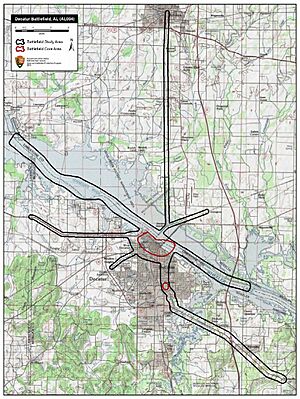Battle of Decatur facts for kids
Quick facts for kids Battle of Decatur |
|||||||
|---|---|---|---|---|---|---|---|
| Part of the American Civil War | |||||||
|
|||||||
| Belligerents | |||||||
| Commanders and leaders | |||||||
| Robert S. Granger | John B. Hood | ||||||
| Strength | |||||||
| 3,000–5,000 | 39,000 | ||||||
| Casualties and losses | |||||||
| 155 | 450 | ||||||
The Battle of Decatur was a small but important event during the American Civil War. It happened from October 26 to October 29, 1864. This battle was part of a bigger plan called the Franklin–Nashville campaign. Union soldiers, led by Brig. Gen. Robert S. Granger, stopped a much larger Confederate army. The Confederates, led by Gen. John Bell Hood, were trying to cross the Tennessee River at Decatur, Alabama. The Union army successfully prevented Hood's forces from crossing, which was a victory for them.
Background
General John Bell Hood was marching his Confederate army through northern Alabama. His main goal was to invade Union-held Tennessee. He had left Atlanta, Georgia in late September 1864. Hood hoped that by destroying Union supply lines, he could make Maj. Gen. William Tecumseh Sherman's Union army fight him.
Sherman chased Hood for a while. But then, Sherman decided to return to Atlanta. He planned to march his army through Georgia to the sea instead. Sherman gave the job of defending Tennessee to Maj. Gen. George Henry Thomas in Nashville.
Hood left Gadsden, Alabama, on October 22. He planned to cross the Tennessee River at Guntersville, Alabama. However, he learned that Guntersville was heavily guarded. A cavalry general named Phillip Roddey told him that Decatur, about forty miles west, was "lightly guarded." Hood was also worried about Union gunboats destroying any bridge he built. He also didn't have his cavalry leader, Nathan Bedford Forrest, to get information. So, Hood changed his plan and headed for Decatur.
The Battle
When Hood arrived at Decatur on October 26, he found a strong Union force. There were 3,000 to 5,000 Union soldiers. They were defending a line with two forts and long trenches. This was much more protection than Roddey had thought. Also, two Union gunboats were patrolling the river.
General George Thomas, in Nashville, quickly sent more supplies and soldiers to Decatur. He ordered them to "defend Decatur to the last extremity," meaning to fight until the very end. On October 27, Hood arranged his army to surround Decatur. The Union reinforcements arrived just in time to fill gaps in their lines.
The next morning, Hood sent Confederate skirmishers forward in a thick fog. They got within 800 yards of the main Union forts. Around noon, a Union regiment pushed these skirmishers back. They captured 125 Confederate soldiers. Hood knew his soldiers were hungry and supplies were low. He decided he could not afford to lose many men in a full attack. So, he chose to cross the Tennessee River somewhere else. He marched his army further west. He crossed the river near Tuscumbia, Alabama, where Muscle Shoals prevented the Union gunboats from interfering.
See also
 In Spanish: Batalla de Decatur para niños
In Spanish: Batalla de Decatur para niños


